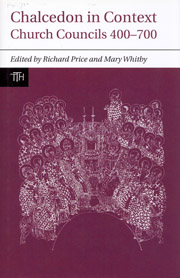Book contents
- Frontmatter
- Contents
- Abbreviations
- List of Contributors
- Introduction
- The Council of Chalcedon and the Definition of Christian Tradition
- ‘Reading’ the First Council of Ephesus (431)
- The Syriac Acts of the Second Council of Ephesus (449)
- The Council of Chalcedon (451): A Narrative
- Truth, Omission, and Fiction in the Acts of Chalcedon
- Why Did the Syrians reject the Council of Chalcedon?
- The Second Council of Constantinople (553) and the Malleable Past
- The Lateran Council of 649 as an Ecumenical Council
- The Quinisext Council (692) as a Continuation of Chalcedon
- Acclamations at the Council of Chalcedon
- An Unholy Crew? Bishops Behaving Badly at Church Councils
- Index
Acclamations at the Council of Chalcedon
- Frontmatter
- Contents
- Abbreviations
- List of Contributors
- Introduction
- The Council of Chalcedon and the Definition of Christian Tradition
- ‘Reading’ the First Council of Ephesus (431)
- The Syriac Acts of the Second Council of Ephesus (449)
- The Council of Chalcedon (451): A Narrative
- Truth, Omission, and Fiction in the Acts of Chalcedon
- Why Did the Syrians reject the Council of Chalcedon?
- The Second Council of Constantinople (553) and the Malleable Past
- The Lateran Council of 649 as an Ecumenical Council
- The Quinisext Council (692) as a Continuation of Chalcedon
- Acclamations at the Council of Chalcedon
- An Unholy Crew? Bishops Behaving Badly at Church Councils
- Index
Summary
One of the more startling aspects of the conciliar acts is the regular recording of acclamations. To a modern reader, they appear intrusive and inappropriate, not least because in modern writing-based societies, cheering and shouting by groups has become increasingly marginalized: it is associated with disorder and disruption, even if it has an established role in certain situations, such as sporting events. This sense of what is appropriate is also influenced by a modern belief in the value of individual commitment. To a modern reader, the statements attributed to the individual bishops seem more significant than the ‘shouts’ of the group as a whole. But in a pre-individual society, such shouts have a very different significance.
Acclamations can be found throughout the ancient Near East, and in both the Jewish and the Graeco-Roman tradition. Their primary function must be one of communication in a non-literate form. In both cultures they seem to be closely associated with religious practice. When the people of Ephesus were being encouraged to oppose the Christian apostle Paul, the crowd in the theatre was encouraged to shout the cult acclamation ‘Great is Artemis of the Ephesians’. This will have been a familiar chant from their normal religious ceremonies; it is therefore understandable that they proceeded to repeat the acclamation over a period of two hours.
- Type
- Chapter
- Information
- Chalcedon in ContextChurch Councils 400-700, pp. 169 - 177Publisher: Liverpool University PressPrint publication year: 2011
- 2
- Cited by

